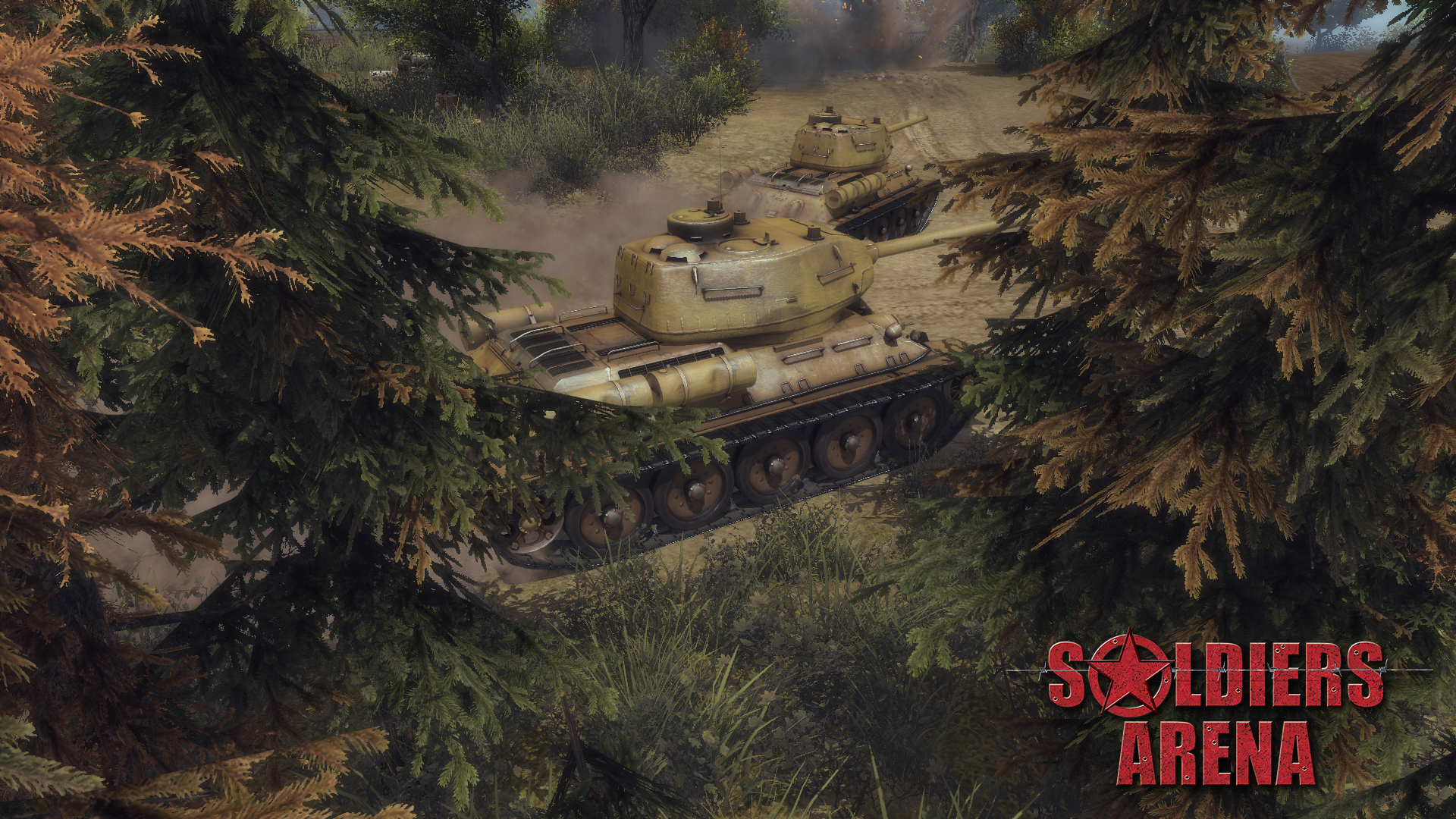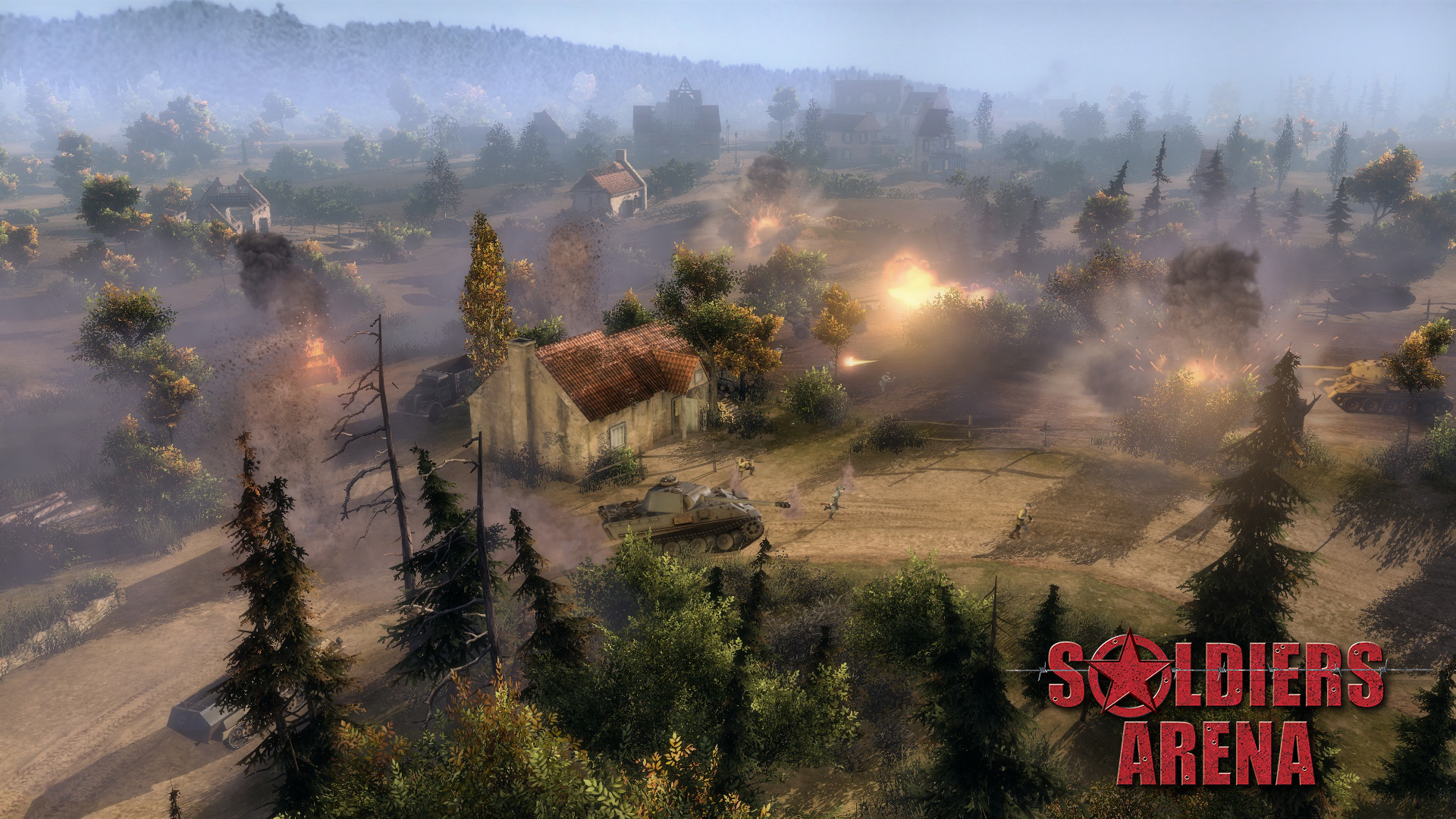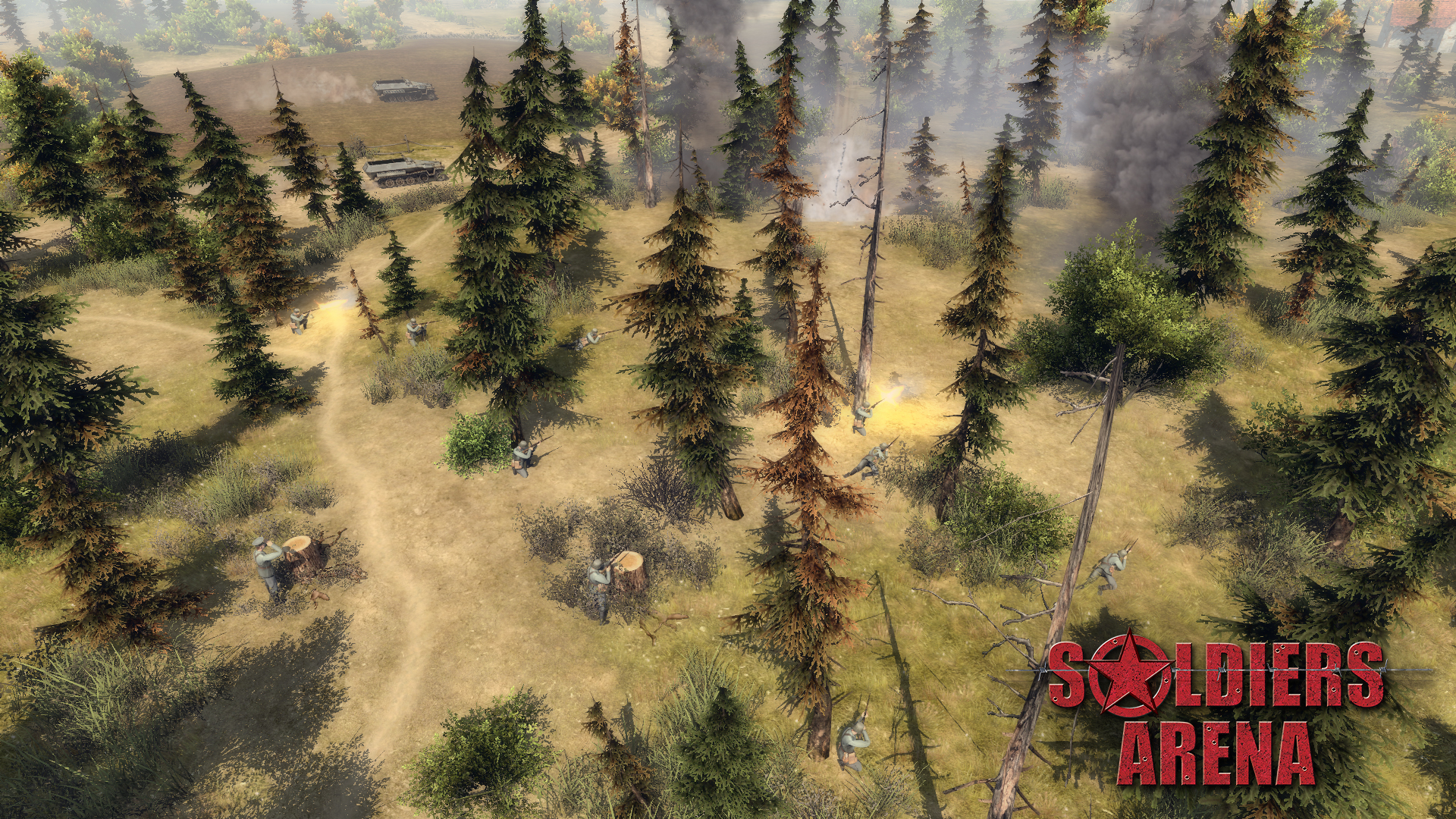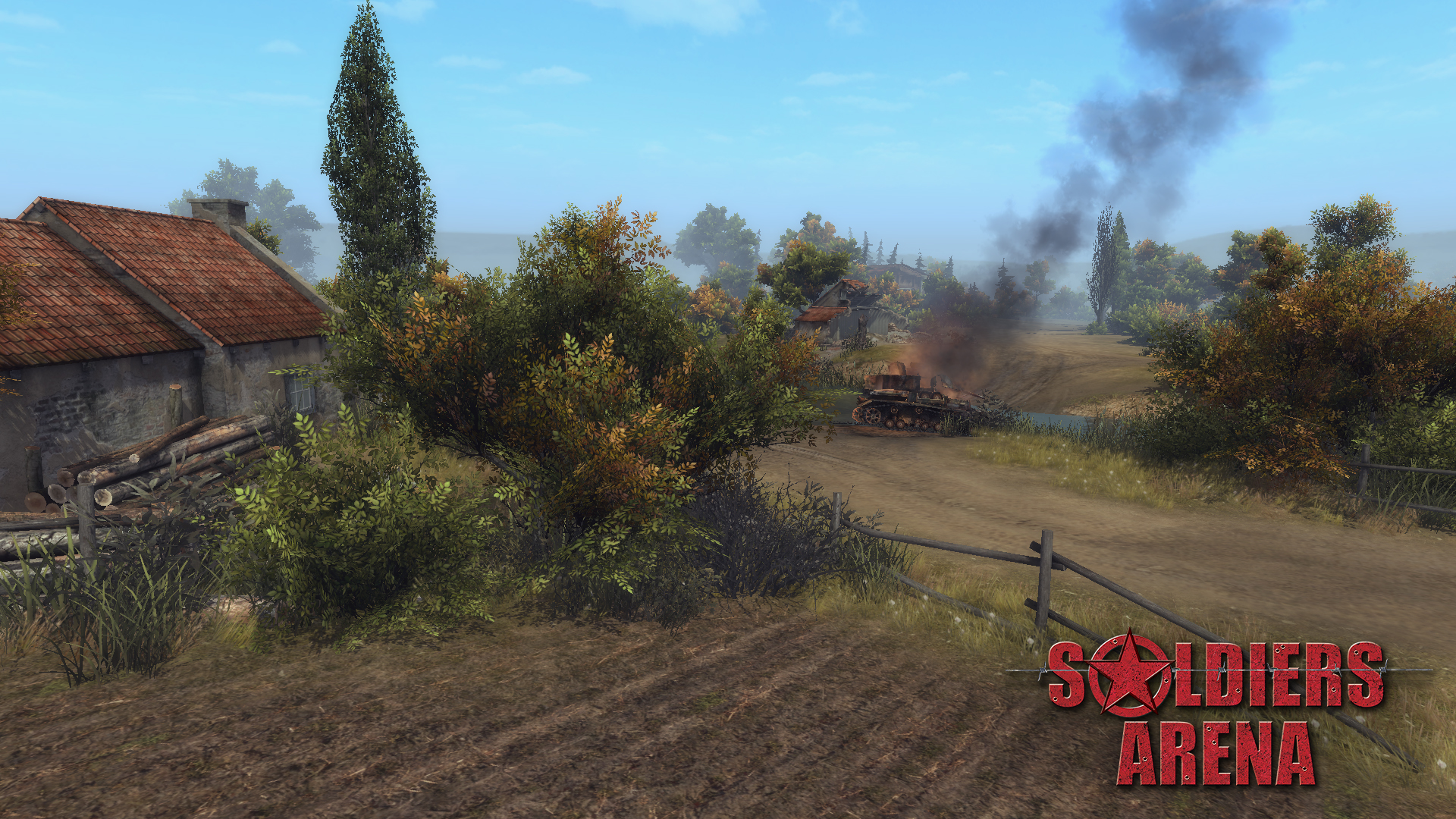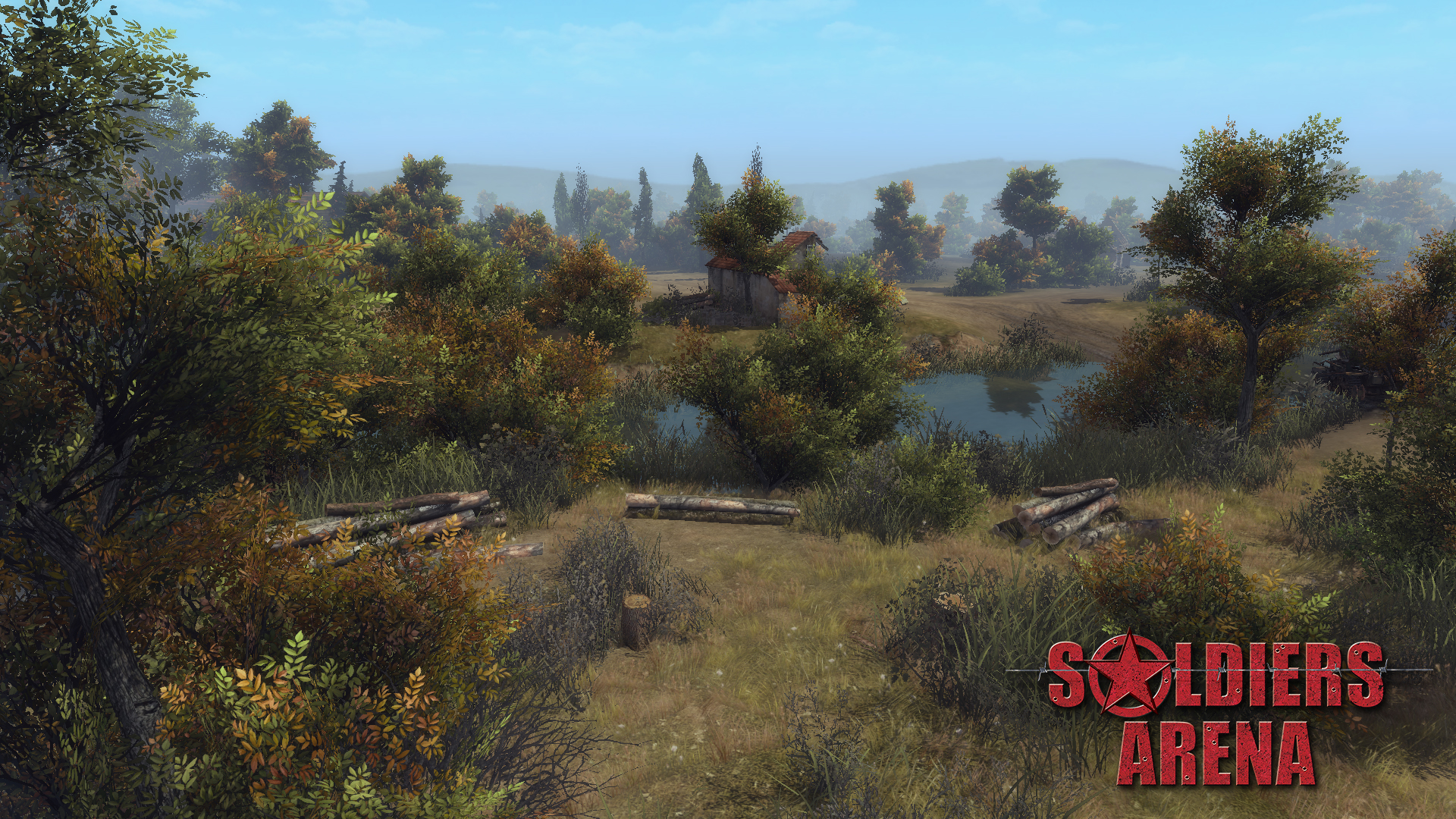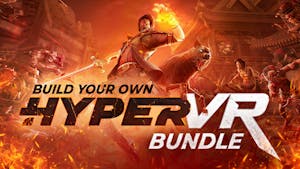Soldiers: Arena will take you to the battlefields driven by the largest and bloodiest conflict of all time - World War II. This is the height of war, this is the time for real heroes.
Both new and already battle-proven multiplayer gamemodes to the original tactical gameplay are waiting for you. Interactive destructible environments and the ability to direct-control any combat unit. Steam support: matchmaking, workshop, steamcloud. Redesigned graphics, models and special effects. Conceptual new interface and convenient control, new battlefields and new opportunities.
Both new and already battle-proven multiplayer gamemodes to the original tactical gameplay are waiting for you. Interactive destructible environments and the ability to direct-control any combat unit. Steam support: matchmaking, workshop, steamcloud. Redesigned graphics, models and special effects. Conceptual new interface and convenient control, new battlefields and new opportunities.
Features:
- Revival of the “Men of War/Soldiers” game series. This multiplayer tactical RTS absorbed the best of the original series, favourite of players all over the world.
- Huge roster of units. Within a single game session, players will have access to a large number of unique units for every nation: tanks, vehicles, infantry and artillery of various types.
- The “Direct Control” mode. This mode provides the ability to play from the third person for any unit in the player’s army. The movement of the unit, firing the various guns, control of ammunition types, etc. all relying and directly controlled by player and thus the game conveys tactical action in it’s very essence.
- Destructible interactive environments. During the battle almost any object of the game can be destroyed or set on fire. Furthermore, all objects, including craters from explosions, may be used as cover.
- Atmosphere and realism. Even in large-scale game battles, it is necessary to take into account factors such as the supply of fuel and ammunition of each single unit. The precense of inventories for each unit limits the number and size of transported objects. Guns’ accuracy and penetration decreases with distance. Tired soldiers reduce the movement speed during long crossings. The influence of these and many other factors makes possible to reproduce the battles of World War II with a adequate degree of realism, most involving the player into the atmosphere of heated battles of the past.
- Modular realistic damage system. Any vehicle, regardless of its type, is composed of a set of modules that can be broken or destroyed. Types of ammunition, characteristics of guns, shooting distance, angle of armor, armor plate thickness and the threshold of material fatigue are taken into account, when calculating the piercing capability and damage caused to each of the component. Additionally, there are calculations of the probability of detonation of ammunition, engine fires, damage to wheels or tracks (which leads to immobilization of combat units). If a component is not destroyed, it can be repaired.
- Wide range of opportunities for infantry. Intelligence, combat, capture and repair of equipment, installation of anti-personnel and anti-tank obstacules of different types, construction of protective structures, health treatment, cover usage, ability to change through primary and secondary weapons, capture of buildings and territories.
- Great number of different types of weapons and ammunition. Pistols, submachine guns, machine guns, rifles and carbines, various types of grenades, dynamite, mines, knives and other items of equipment that are unique to each nation.
- Advanced Artificial Intelligence (Advanced AI). Infantry’s behaviour based on the feedback information from their own sensors (vision and acoustics), as well as allies’ signals. This allows the use of diversionary tactics, sending scouts into the enemy's rear, as well as to open the visibility with the help of special devices - observation towers, binoculars, telescopic tubes and sniper scopes. The morale of the infantry depends on the balance of forces on the battlefield - the soldiers may decide to advance or to withdraw from the fight.
- Conceptual new interface for convenient control.
- Enhanced game engine Gem2. Reworking of the game engine allows to provide a new level of graphics, the implementation of new and improvement already familiar to users game mechanics.
- OSX, Mac. Linux support.
- Full Steam support. Matchmaking, workshop, steamcloud, tradecards, achievments, steamstats, inventoryitems.
DevDiaries #52: SPG
The history of self-propelled artillery originates during the Thirty Years' War in the 17th century, and according to some sources even during the Hundred Years War in the 15th century. But they used to call it Horse artillery those days. But there was an evident problem that had to be solved- insufficient mobility for artillery. This could be approached by installing the gun on a movable base, whether it is the chassis of a tank, a cart or a camel’s back - it follows the same principle.
photo link
As you can see from the photo with the Zamburak (and his rider), artillerymen of those different times did not like to sit on the ground in anticipation of a counterstrike and tried their best to keep up with the advancing allies. The main role of an SPG is to provide direct fire support for tanks and infantry in the battle, and they have enough equipment for this job, because the self-propelled guns picked the best bits from artillery and tanks. The majority of SPGs have a gun more powerful than an equivalent main battle tank’s one, due to the longer barrel and more sophisticated targeting and sighting equipment, and it’s also able to perform indirect fire, while tanks are forced to restrict themselves to direct fire only. Unlike towed artillery, SPGs are able to accompany allied forces during deep breakthroughs of the enemy defenses, and can also quickly retreat from the firing positions before the enemy can detect it. Thus, mobile artillery are much more effective in the artillery offensive actions, for which the “Infantry tactical manual of the Red Army (1942 edition)” defines: ‘The artillery offense consists in the continuous support of the infantry with a massive artillery and mortar fire during the entire period of the offensive. Artillery and mortar fire must lead the infantry and tanks in the attack from one object of defense to another.’
These qualities can often become decisive when choosing a favorite commander. However, one must also remember the disadvantages: support for the allies in the offensive does not mean an offensive solely on your own, your armour doesn’t stack up against a similar tank’s one, but the cost is no longer the cost of artillery.
In the game, we try to reflect the entire diversity of the SPGs of WW2 and their strengths and weaknesses. The gun of the mobile artillery has greater armor piercing capabilities and an effective range of fire compared to a similar tank’s one. Some of the units in this category also have very good armor. No doubt, the SU-152 or Jagdpanther, even from afar, do not resemble a ‘day-off’ car with an open top. While the crew of a cannon has to go guns blazing upon the sight of enemy infantry to make sure they can deal as much damage as they can, while they can, the SPG crew can retreat or respond with fire themselves (although it is still more reliable to retreat). The self-propelled guns do not depend on tractors for towing, and the time of their combat deployment is much lower, plus they do not start to be visible after the first shot, like tanks. So if you have all the advantages of artillery invisibility and tank armor, you can destroy tanks with armor-piercing shells, and enemy howitzers with HE-shells, while being relatively safe. And you can be greedy, shooting in plain sight and hoping for luck, which smiles much more often to mobile artillery than to the rest. Most likely you will manage to survive most of the high-explosive shells and some armor-piercing, and with a high probability you will win in a counterbattery duel. But do not consider the SPG as the solution of all problems. Armor of the majority of these units (except for the late-war and especially expensive ones) are only sufficient to stop rifle-caliber bullets, and the open-top does may not even be able to stand up to that. And no matter how good you are at killing the enemy, it is unlikely you will go much deeper into his territory. Attacking without the support of an ally-infantryman is plain suicide. The grenade launchers will very quickly lecture you on why advancing head-on is a bad idea, especially so since you have disappointing circular viewports and often lacking machine guns. And indeed we can say that the thickness of your armor really is not a matter of concern for those geeses.
screenshot link
Every unit in the game has it’s own role, and if you are given tracks and invisibility - use both of them! The rest of the artillery commanders emphasize strengthening their positions, but the SPG commander needs to be mobile and constantly change location. You found a target, made several shots, began to spawn circles - step back. You saw that there is an incoming plane with paratroopers - step back. You saw that you almost got into the enemy's viewport - step back immediately! The choice of targets is no less important than the choice of position, and the commander of self-propelled guns can be created in different ways. You can focus on the AT-SPG and have the ability to fire 'from the fog' and destroy even the heaviest, expensive and seemingly invincible enemy tank. Or focus on assault SPGs and be a worst nightmare of infantry and artillery. Or take a little bit of everything and ... well, at least you can ride some. However, who knows? Soldiers: Arena is still a team game and such a universal commander can be the right addition for your clan super-duper strategy. Sometimes it happens that a couple of destroyed machine guns and AT-cannons far beyond the front line can help the ally to a larger extent than killing the most expensive enemy unit. In the end, what can such clumsy tanks do when surrounded?
Earlier we already wrote that we are not trying to mirror the units, and we are doing our best to make the game for one commander very different depending on from the chosen faction. We believe that this will be both more realistic and interesting. For example, Soviet mobile artillery are almost always an assault or direct support cannon, with the most powerful frontal armor, and an gun more powerful than that of an enemy of the same class, but almost always without machine guns. While almost every SPG of the Allies is equipped with a 50-caliber machine gun and has a rotating but open-top tower. In addition, playing for the Allies in the early game you don't need to be afraid of the counterstrike of artillery and howitzers, thanks to the M8 Scott’s armor. And Germany has a self-propelled gun of any weight and form for almost every task, in the early game you can rely on Sturmpanzer and Wespe, and in late on Jagdtiger and Sturmtiger assault gun.
This is all for today. As always, do not hesitate to write in the comments, which units from the category under discussion you are waiting for. It may be that they will appear in the game. Still wish you all the best of luck!
render link
Hi, friends.
It's strange that haven’t talked about mobile artillery for so long. After all, it’s the only thing that unites the realms of tankmen and artillerymen. They both recognize SPG as their own, and even the infantry has to admit that there is something in mobile artillery.
Pimp my cannon
The history of self-propelled artillery originates during the Thirty Years' War in the 17th century, and according to some sources even during the Hundred Years War in the 15th century. But they used to call it Horse artillery those days. But there was an evident problem that had to be solved- insufficient mobility for artillery. This could be approached by installing the gun on a movable base, whether it is the chassis of a tank, a cart or a camel’s back - it follows the same principle.
photo link
As you can see from the photo with the Zamburak (and his rider), artillerymen of those different times did not like to sit on the ground in anticipation of a counterstrike and tried their best to keep up with the advancing allies. The main role of an SPG is to provide direct fire support for tanks and infantry in the battle, and they have enough equipment for this job, because the self-propelled guns picked the best bits from artillery and tanks. The majority of SPGs have a gun more powerful than an equivalent main battle tank’s one, due to the longer barrel and more sophisticated targeting and sighting equipment, and it’s also able to perform indirect fire, while tanks are forced to restrict themselves to direct fire only. Unlike towed artillery, SPGs are able to accompany allied forces during deep breakthroughs of the enemy defenses, and can also quickly retreat from the firing positions before the enemy can detect it. Thus, mobile artillery are much more effective in the artillery offensive actions, for which the “Infantry tactical manual of the Red Army (1942 edition)” defines: ‘The artillery offense consists in the continuous support of the infantry with a massive artillery and mortar fire during the entire period of the offensive. Artillery and mortar fire must lead the infantry and tanks in the attack from one object of defense to another.’
These qualities can often become decisive when choosing a favorite commander. However, one must also remember the disadvantages: support for the allies in the offensive does not mean an offensive solely on your own, your armour doesn’t stack up against a similar tank’s one, but the cost is no longer the cost of artillery.
An artilleryman who doesn't want to be a self-propelled artilleryman is a bad artilleryman.
In the game, we try to reflect the entire diversity of the SPGs of WW2 and their strengths and weaknesses. The gun of the mobile artillery has greater armor piercing capabilities and an effective range of fire compared to a similar tank’s one. Some of the units in this category also have very good armor. No doubt, the SU-152 or Jagdpanther, even from afar, do not resemble a ‘day-off’ car with an open top. While the crew of a cannon has to go guns blazing upon the sight of enemy infantry to make sure they can deal as much damage as they can, while they can, the SPG crew can retreat or respond with fire themselves (although it is still more reliable to retreat). The self-propelled guns do not depend on tractors for towing, and the time of their combat deployment is much lower, plus they do not start to be visible after the first shot, like tanks. So if you have all the advantages of artillery invisibility and tank armor, you can destroy tanks with armor-piercing shells, and enemy howitzers with HE-shells, while being relatively safe. And you can be greedy, shooting in plain sight and hoping for luck, which smiles much more often to mobile artillery than to the rest. Most likely you will manage to survive most of the high-explosive shells and some armor-piercing, and with a high probability you will win in a counterbattery duel. But do not consider the SPG as the solution of all problems. Armor of the majority of these units (except for the late-war and especially expensive ones) are only sufficient to stop rifle-caliber bullets, and the open-top does may not even be able to stand up to that. And no matter how good you are at killing the enemy, it is unlikely you will go much deeper into his territory. Attacking without the support of an ally-infantryman is plain suicide. The grenade launchers will very quickly lecture you on why advancing head-on is a bad idea, especially so since you have disappointing circular viewports and often lacking machine guns. And indeed we can say that the thickness of your armor really is not a matter of concern for those geeses.
screenshot link
Every unit in the game has it’s own role, and if you are given tracks and invisibility - use both of them! The rest of the artillery commanders emphasize strengthening their positions, but the SPG commander needs to be mobile and constantly change location. You found a target, made several shots, began to spawn circles - step back. You saw that there is an incoming plane with paratroopers - step back. You saw that you almost got into the enemy's viewport - step back immediately! The choice of targets is no less important than the choice of position, and the commander of self-propelled guns can be created in different ways. You can focus on the AT-SPG and have the ability to fire 'from the fog' and destroy even the heaviest, expensive and seemingly invincible enemy tank. Or focus on assault SPGs and be a worst nightmare of infantry and artillery. Or take a little bit of everything and ... well, at least you can ride some. However, who knows? Soldiers: Arena is still a team game and such a universal commander can be the right addition for your clan super-duper strategy. Sometimes it happens that a couple of destroyed machine guns and AT-cannons far beyond the front line can help the ally to a larger extent than killing the most expensive enemy unit. In the end, what can such clumsy tanks do when surrounded?
Earlier we already wrote that we are not trying to mirror the units, and we are doing our best to make the game for one commander very different depending on from the chosen faction. We believe that this will be both more realistic and interesting. For example, Soviet mobile artillery are almost always an assault or direct support cannon, with the most powerful frontal armor, and an gun more powerful than that of an enemy of the same class, but almost always without machine guns. While almost every SPG of the Allies is equipped with a 50-caliber machine gun and has a rotating but open-top tower. In addition, playing for the Allies in the early game you don't need to be afraid of the counterstrike of artillery and howitzers, thanks to the M8 Scott’s armor. And Germany has a self-propelled gun of any weight and form for almost every task, in the early game you can rely on Sturmpanzer and Wespe, and in late on Jagdtiger and Sturmtiger assault gun.
This is all for today. As always, do not hesitate to write in the comments, which units from the category under discussion you are waiting for. It may be that they will appear in the game. Still wish you all the best of luck!
[ 2017-12-07 19:28:33 CET ] [Original Post]
Minimum Setup
- OS: Ubuntu 12.04
- Processor: 2 GHz Intel Dual CoreMemory: 4 GB RAM
- Memory: 4 GB RAM
- Graphics: 3D Hardware Accelerator Card Required - OpenGL 3.0 compatibleNetwork: Broadband Internet connection
- Storage: 5 GB available space
Recommended Setup
- OS: Ubuntu 15.04
- Processor: Intel Core i5-2.5GHzMemory: 8 GB RAM
- Graphics: NVIDIA GeForce GTX 560 or AMD Radeon HD 7750 with 1 GB VRAM or betterNetwork: Broadband Internet connection
- Storage: 5 GB available space
GAMEBILLET
[ 6376 ]
FANATICAL
[ 5865 ]
GAMERSGATE
[ 751 ]
MacGameStore
[ 2194 ]
FANATICAL BUNDLES
GMG BUNDLES
HUMBLE BUNDLES
INDIEGALA BUNDLES
by buying games/dlcs from affiliate links you are supporting tuxDB

